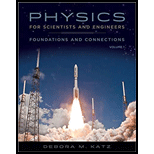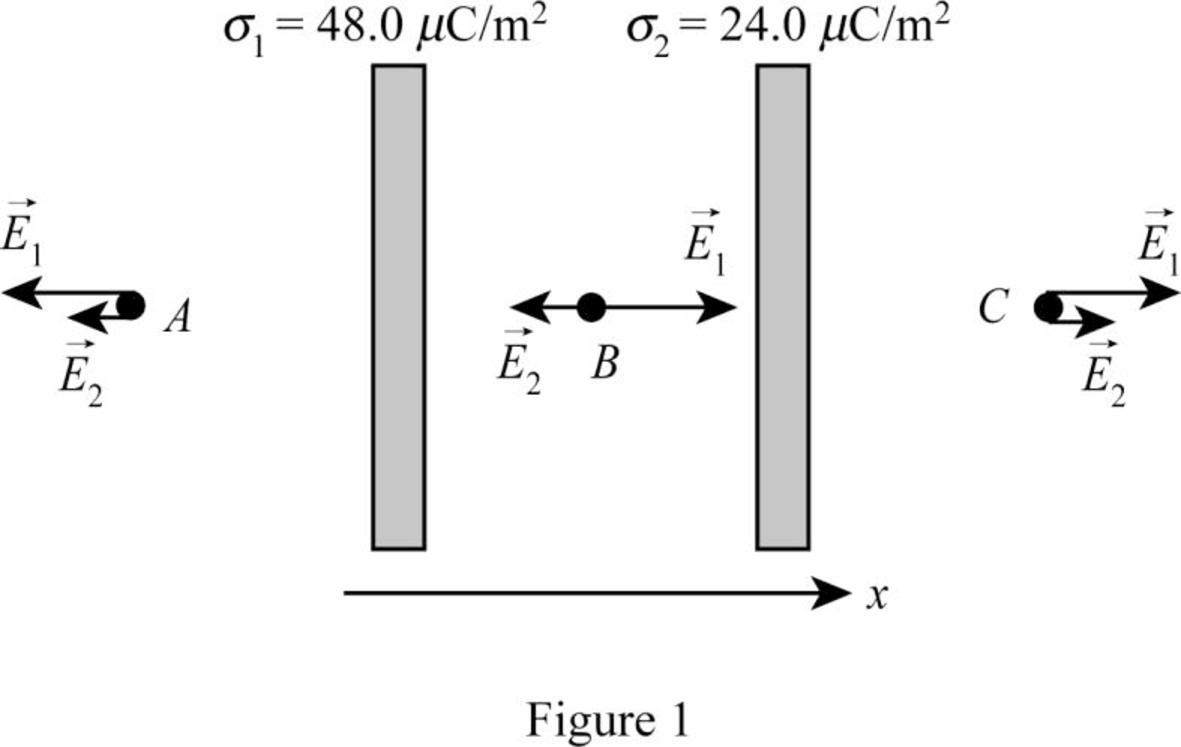
Concept explainers
The infinite sheets in Figure P25.47 are both positively charged. The sheet on the left has a uniform surface charge density of 48.0 μC/m2, and the one on the right has a uniform surface charge density of 24.0 μC/m2.
- a. What are the magnitude and direction of the net electric field at points A, B, and C?
- b. What is the force exerted on an electron placed at points A, B, and C?

FIGURE P25.47
(a)
The magnitude and direction of the net electric fields at points
Answer to Problem 47PQ
The magnitude and direction of the net electric fields at points
Explanation of Solution
Write the expression for finding the electric field due to first sheet.
Here,
Write the expression for finding the electric field due to second sheet.
Here,
The following figure shows the direction and the sum of the fields at points

Write the expression to find the electric field at point
Write the expression to find the electric field at point
Write the expression to find the electric field at point
Conclusion:
Substitute
Substitute
Substitute
Substitute
Substitute
Therefore, the magnitude and direction of the net electric fields at points
(b)
The force exerted on an electron placed at points
Answer to Problem 47PQ
The force exerted on an electron placed at points
Explanation of Solution
Write the expression for the force exerted on the electron.
Here,
Conclusion:
Substitute
Substitute
Substitute
Therefore, the force exerted on an electron placed at points
Want to see more full solutions like this?
Chapter 25 Solutions
Student Solutions Manual For Katz's Physics For Scientists And Engineers: Foundations And Connections, Volume 1
- Two infinitely long, parallel lines of charge with linear charge densities 3.2 C/m and 3.2 C/m are separated by a distance of 0.50 m. What is the net electric field at points A, B, and C as shown in Figure P25.35? FIGURE P25.35arrow_forwardA solid, insulating sphere of radius a has a uniform charge density throughout its volume and a total charge Q. Concentric with this sphere is an uncharged, conducting, hollow sphere whose inner and outer radii are b and e as shown in Figure P24.45. We wish to understand completely the charges and electric fields at all locations. (a) Find the charge contained within a sphere of radius r a. (b) From this value, find the magnitude of the electric field for r a. (c) What charge is contained within a sphere of radius r when a r b? (d) From this value, find the magnitude of the electric field for r when a r b. (e) Now consider r when b r c. What is the magnitude of the electric field for this range of values of r? (f) From this value, what must be the charge on the inner surface of the hollow sphere? (g) From part (f), what must be the charge on the outer surface of the hollow sphere? (h) Consider the three spherical surfaces of radii a, b, and c. Which of these surfaces has the largest magnitude of surface charge density? Figure P24.45 Problems 43 and 47.arrow_forwardA When we find the electric field due to a continuous charge distribution, we imagine slicing that source up into small pieces, finding the electric field produced by the pieces, and then integrating to find the electric field. Lets see what happens if we break a finite rod up into a small number of finite particles. Figure P24.77 shows a rod of length 2 carrying a uniform charge Q modeled as two particles of charge Q/2. The particles are at the ends of the rod. Find an expression for the electric field at point A located a distance above the midpoint of the rod using each of two methods: a. modeling the rod with just two particles and b. using the exact expression E=kQy12+y2 c. Compare your results to the exact expression for the rod by finding the ratio of the approximate expression to the exact expression. FIGURE P24.77 Problems 77 and 78.arrow_forward
- A very long, thin wire fixed along the x axis has a linear charge density of 3.2 C/m. a. Determine the electric field at point P a distance of 0.50 m from the wire. b. If there is a test charge q0 = 12.0 C at point P, what is the magnitude of the net force on this charge? In which direction will the test charge accelerate?arrow_forwardFigure P24.51 shows four small charged spheres arranged at the corners of a square with side d = 25.0 cm. a. What is the electric field at the location of the sphere with charge +2.00 nC? b. What is the total electric force exerted on the sphere with charge +2.00 nC by the other three spheres? FIGURE P24.51arrow_forwardThe colored regions in Figure P25.21 represent four three-dimensional Gaussian surfaces A through D. The regions may also contain three charged particles, with qA + +5.00 nC, qB = 5.00 nC, and qC = +8.00 nC, that are nearby as shown. What is the electric flux through each of the four surfaces? FIGURE P25.21arrow_forward
- If the magnitude of the surface charge density of the plates in Figure P25.55 is = 99.5 nC/m2, what is the magnitude of the electric field between the plates? If an electron is placed between the plates, what is the magnitude of the electric force on it? FIGURE P25.55arrow_forwardA positively charged disk of radius R = 0.0366 m and total charge 56.8 C lies in the xz plane, centered on the y axis (Fig. P24.35). Also centered on the y axis is a charged ring with the same radius as the disk and a total charge of 34.1 C. The ring is a distance d = 0.0050 m above the disk. Determine the electric field at the point P on the y axis, where P is y = 0.0100 m above the origin. FIGURE P24.35 Problems 35 and 36.arrow_forwardFigure P24.20 shows three charged spheres arranged along the y axis. a. What is the electric field at x = 0, y = 3.00 m? b. What is the electric field at x = 3.00 m, y = 0? FIGURE P24.20arrow_forward
- A uniform electric field given by E=(2.655.35j)105N/C permeates a region of space in which a small negatively charged sphere of mass 1.30 g is suspended by a light cord (Fig. P24.53). The sphere is found to be in equilibrium when the string makes an angle = 23.0. a. What is the charge on the sphere? b. What is the magnitude of the tension in the cord? FIGURE P24.53arrow_forwardA sphere with a charge of 3.50 nC and a radius of 1.00 cm is located at the origin of a coordinate system. a. What is the electric field 1.75 cm away from the center of the sphere along the positive y axis? b. If a particle with a charge of 5.39 nC were placed at that location, what would be the electrostatic force on this charge?arrow_forwardA solid insulating sphere of radius a = 5.00 cm carries a net positive charge of Q = 3.00 C uniformly distributed throughout its volume. Concentric with this sphere is a conducting spherical shell with inner radius b = 10.0 cm and outer radius c = 15.0 cm as shown in Figure P24.54, having net charge q = 1.00 C Prepare a graph of the magnitude of the electric field due to this configuration versus r for O r 25.0 cm.arrow_forward
 Physics for Scientists and Engineers: Foundations...PhysicsISBN:9781133939146Author:Katz, Debora M.Publisher:Cengage Learning
Physics for Scientists and Engineers: Foundations...PhysicsISBN:9781133939146Author:Katz, Debora M.Publisher:Cengage Learning Physics for Scientists and Engineers with Modern ...PhysicsISBN:9781337553292Author:Raymond A. Serway, John W. JewettPublisher:Cengage Learning
Physics for Scientists and Engineers with Modern ...PhysicsISBN:9781337553292Author:Raymond A. Serway, John W. JewettPublisher:Cengage Learning Physics for Scientists and EngineersPhysicsISBN:9781337553278Author:Raymond A. Serway, John W. JewettPublisher:Cengage Learning
Physics for Scientists and EngineersPhysicsISBN:9781337553278Author:Raymond A. Serway, John W. JewettPublisher:Cengage Learning Physics for Scientists and Engineers, Technology ...PhysicsISBN:9781305116399Author:Raymond A. Serway, John W. JewettPublisher:Cengage Learning
Physics for Scientists and Engineers, Technology ...PhysicsISBN:9781305116399Author:Raymond A. Serway, John W. JewettPublisher:Cengage Learning Principles of Physics: A Calculus-Based TextPhysicsISBN:9781133104261Author:Raymond A. Serway, John W. JewettPublisher:Cengage Learning
Principles of Physics: A Calculus-Based TextPhysicsISBN:9781133104261Author:Raymond A. Serway, John W. JewettPublisher:Cengage Learning




